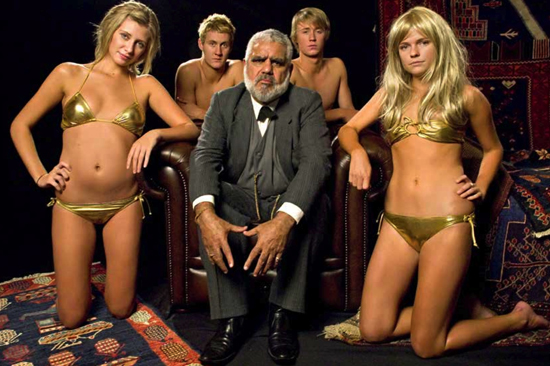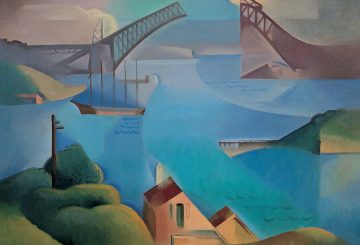Sharne Wolff interviewed Richard Bell. He gave answers. She wrote them down.
Sharne Wolff: The title of your current show at Monash University Museum of Art (MUMA) is Lessons on Etiquette and Manners. What section of the audience are the ‘Lessons’ directed to?
Richard Bell: Everyone who isn’t a de-colonised Blackfella.
SW: Which part of your practice is on view at the MUMA exhibition?
RB: The stuff that’s left when I finish making it.
SW: One of my personal favourites of recent years is your video work entitled
‘Scratch an Aussie’ (2008). What lessons are you trying to get across to the audience in that piece?
RB: Scratch an Aussie was the second video I made. I like to make videos in a similar way to the way I make paintings by layering. In this way, the viewer is encouraged to look beneath the surface.
SW: Does it bother you that your work intimidates some members of the audience – or is that part of the point?
RB: It doesn’t bother me tho I am aware of it. It is a deliberate tactic that allows me to invoke anger without expressing it myself. I know that sometimes people will be switched off by that tactic but an ostrich will bury its head in the sand.
SW: One of the major works in this exhibition is a new commissioned installation work entitled ‘A prelude to imagining victory’ (2012-13) Can you tell us a bit of the history involved in that piece?
RB: It refers to the original Aboriginal Tent Embassy in 1972 which was actually just a beach umbrella. The Banana Chairs and esky are a little extravagant but I had way better budget than those guys in ’72.
SW: Will the MUMA exhibition be touring to other States?
RB: Don’t reckon so.
SW: You’ve said in the past that you’re “an activist who masquerades as an artist”. Does this mean the message in your work is more important to you than the aesthetic?
RB: Yes.
SW: You’ve always been a vocal opponent of Australian artists appropriating the work of Aboriginal artists. The painting ‘Bell’s Theorem (Trikky Dikky and Friends)’ from 2005 names a number of artists that you accuse of appropriation. More recently, you’ve mentioned artists such as Lucas Grogan and (Archibald prize winner) Del Kathryn Barton as potential wrongdoers. Can you explain the reasons for your anger about this issue to readers of The Art Life?
RB: Short answer. This has all been discussed before, at length. Do your research. Suffice to say, I’m not allowed to appropriate Aboriginal Art and nor is any other Blackfella who is not from the desert areas or Arnhem Land. So why should White artists be allowed? The fact is, not only are they allowed to, they are celebrated for doing so. Grogan and Barton are both so bad at it yet are so celebrated. Grogan is a good designer. Del Kathryn Barton is a great illustrator. There is no need for them to appropriate Aboriginal Art. To continually engage in the appropriation of Aboriginal Art is a colonial act in this supposedly post-colonial era.
SW: Does it make any difference to your argument that artists might have ‘appropriated’ aboriginal work either innocently or naively? Alternatively, are you able to view the appropriation as a form of flattery, or attempt at reconciliation? In other words, in your view is there any room for debate?
RB: No. It doesn’t make any difference if these artists might have appropriated Aboriginal Art innocently or naively because ignorance is not an excuse. The artists you mention are both Art School trained. During their time at Art School they would have learnt about how Margaret Preston paid homage to the Aboriginal people. And homage was all she paid. But, they surely have been also made aware of Aboriginal Art and that it is considered, in many circles of the art world, inappropriate to appropriate Aboriginal Art. In my opinion, it is highly unlikely that either artist was unaware of the risks they ran in appropriating Aboriginal Art. In fact, many Blackfellas reckon that White artists deliberately use Aboriginal Art as a kind of trampoline to get noticed. For this kind of appropriation to begin to approach flattery would need an entire lesson on etiquette and manners and would definitely not to be retrospectively validating previous breaches. As to your question on Reconciliation, let’s get this straight: Reconciliation is an Australian Government program. It did not come from demands from Aboriginal communities. There can be no Reconciliation without there being a Conciliation (Treaty) in the first place. Any reference to Reconciliation raises a red flag for me. Is there room for debate? Better still, there is room for informed debate. Do your research on these issues; look at the debates in the 90’s, for example, Imants Tillers, Juan Davila and the White Aborigines, Gordon Bennett. Even a cursory look at Aboriginal culture and the Papunya School of painters will find you dipping your toes into a sea of uncertainty. Educate yourselves then come back and talk to us.
SW: Are there any circumstances where you feel appropriation by non-Aboriginal artists is acceptable? For instance, is it preferable for artists to seek permission from Aboriginal people? Or work collaboratively with Aboriginal artists?
RB: Yes. Yes. And probably.
SW: Do you think it’s acceptable to hang the artists you accuse in public? If so, why?
RB: No, I don’t.
SW: In the past, you’ve appropriated the work of numerous artists – amongst them Jackson Pollock, Jasper Johns and, of course, Roy Lichtenstein. Why isn’t it hypocritical for you to appropriate the work of other artists?
RB: It has been acceptable practice in Contemporary Art to appropriate other artists’ work from the Western canon. Why are you asking this question? However, given the recent legal problems faced by Jeff Koons and Richard Prince, I have had a rethink about appropriation. If an artist is to be sued for breach of copyright, I would want them to be armed with something more than convoluted art theories.
SW: You’ve been involved in a number of artist groups and now you’re part of the seven member Brisbane collective ProppaNow. Do you find you work better within a group? How?
RB: I do find that I work better within a group. Although most of my work is still made alone, I love the interactivity available to the group. I value the feedback from the group, including critiques. And I’m just a very social creature who thrives in the group dynamic, which in turn, impacts positively on my practice.
SW: You’re one of only two artists named in The Art Life’s 2012 Power Trip of the most powerful people in the Australian art world and further as “probably the most powerful artist in the Australian art world right now”. What do you intend to do with all this power? Can one person or artist make a difference?
RB: Really! Now, that is a power trip. So how does all this power manifest itself? What am I gonna do with this power? I’m gonna demand that all artists are picked up at the airport, bus station, railway station, jetty, etc. if you haven’t got the decency to pick us up, don’t invite us.
SW: There’s been no Richard Bell solo show in Sydney but you’ve had solo exhibitions in Boston and New York and you’ve also been included in exhibitions in numerous other countries. Does it bother you that your work seems to have had a greater level of acceptance by overseas audiences? Do you find overseas audiences receive the work in a different way to Australian audiences? Are you surprised by the reactions?
RB: Nope, it doesn’t bother me. It gives me a warm and fuzzy feeling. Yes. Yes, at first, and then no after processing.
SW: Rex Butler and Ian McLean wrote in a recent essay about your work where they suggested that some of the power of your work comes cloaked with humour and its claims about truth in the form of a good joke. Are you ever trying to be funny?
RB: Can’t you take a joke?
SW: I’m aware that you’ve often said that there’s Richard Bell, the artist, and Richie – Richard’s bold, brash public persona. Which one of you has been answering these questions?
RB: Guess.
Richard Bell
‘Lessons on Etiquette and Manners’
Monash University Museum of Art, Melbourne
Until April 13. Richard Bell is represented by Milani Gallery, Brisbane.
Pic: Richard Bell, Scratch an Aussie, 2008. Courtesy of the artist and Milani Gallery, Brisbane.



Nice work – I do like that Richard Bell actually thinks and answers questions. This is great reading.
He raised a great point about appropriation. Could the art life use their massive pull in the art world and interview Richard Prince and ask him what he thinks of Zavros’ Rockhampton exhibition where he rips off, sorry appropriates, the marlboro men photos?
I like this interview a lot. No warm and cuddly answers there! No luvvie -type grateful-for-the-opportunity responses. Bell has an aim and intentions and no time to pretend to be likable. He has opinions and tells ’em how they are!